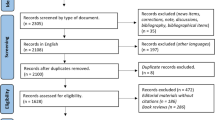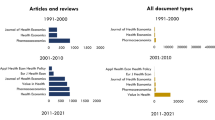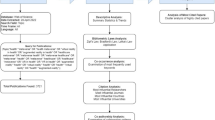Abstract
In the 1970s Mexico started to consolidate its S&T system by training human resources and actively preventing brain drain, mainly by motivating researchers through economic incentives. Considering Bradford"s Law, an analysis of significant Mexican research in the health sciences, i.e., papers published in journals with a high-impact factor which grant a degree of credibility and importance was carried out. Significant papers produced in Mexico show a measure of the country"s productivity, and these papers" citations measure the country"s international impact.
Similar content being viewed by others
References
Science & Technology Indicators: Ibero American 1995–1996. Red Iberoamericana de Indicadores de Ciencia y Tecnología, Buenos Aires, 1999.
Indicadores de actividades científicas y tecnológicas 1998. CONACYT, México, 1999.
J. L. De Arenas, Aligning research activity with national priorities: a case study of Mexican health sciences research. In: B. Cronin, (Ed.), The Knowledge Industries: Levers of Economic and Social Development in the 1990s. ASLIB, London, 1999, pp. 231-239.
J. L. De Arenas, Partial assessment of Mexican health sciences research, 1982–1986, Scientometrics, 23 (1992) 47-55.
J. L. De Arenas, J. Valles, M. Arenas, Profile of the Mexican health sciences elite: a bibliometric analysis of research performance, Scientometrics, 46 (1999) 539-547.
E. Garfield, What is a significant journal? Essays of an Information Scientist, 1 (1962–1973) 106-107.
E. Garfield,The significant scientific literature appears in a small core of journals, The Scientist, 10 (17) (1996).
J. Testa, The ISI database. The journal selection process. Available from: URL: http:///www.isinet.com/whatshot/essays/esay9701.html
C. Bradford, Documentation. Public Affairs Press, Washington, D.C., 1950, 156 p.
E. Garfield, Long-term vs short-term journal impact: Does it matter? The Scientist, 12 (3) (1998) 11-12.
E. Garfield, Long-term vs. short-term impact. Part II, The Scientist, 12 (14) (1998) 12-13.
Pulling together in Latin America, Nature, 398 (1999) 353.
R. Sancho, Misjudgements and shortcomings in the measurement of scientific activities in less-developed countries, Scientometrics, 23 (1992) 221-223.
E. Garfield, How can impact factors be improved? British Medical Journal, 313 (1992) 411-413.
P. Seglen, How representative is the journal impact factor? Research Evaluation, 2 (1992) 143-149.
E. Garfield, Random thoughts on citationology: its theory and practice, Scientometrics, 43 (1999) 69-76.
J. C. R. Pereira, M. M. L. Escuder, The scenario of Brazilian health sciences in the period of 1981 to 1995, Scientometrics, 45 (1999) 95-105.
J. L. De Arenas, B. Cronin, The contribution of higher education institutions to the development of Mexican health sciences base, Journal of Information Science, 15 (1989) 333-338.
B. Cronin, J. Licea De Arenas, The geographic distribution of Mexican health sciences research, Scientometrics, 17 (1989) 39-48.
E. Garfield, To be an uncited scientist is no cause for shame, The Scientist, 5 (6) (1991) 12.
E. Garfield, Introducing Citation Classics: the human side of scientific reports, Essays of an Information Scientist, 3 (1980) 1-2.
ISI recognizes highly cited Mexican authors. Available from: URL: http://www.isinet.com/isi/newsfeatures/mexico/unam.html
K. Alexanderson, An assessment protocol for gender analysis of medical literature, Women & Health, 29 (1999) 81-98.
Author information
Authors and Affiliations
Rights and permissions
About this article
Cite this article
Licea De Arenas, J., Castańos-Lomnitz, H. & Arenas Licea, J. Significant Mexican research in the health sciences: A bibliometric analysis. Scientometrics 53, 39–48 (2002). https://doi.org/10.1023/A:1014879803333
Issue Date:
DOI: https://doi.org/10.1023/A:1014879803333




